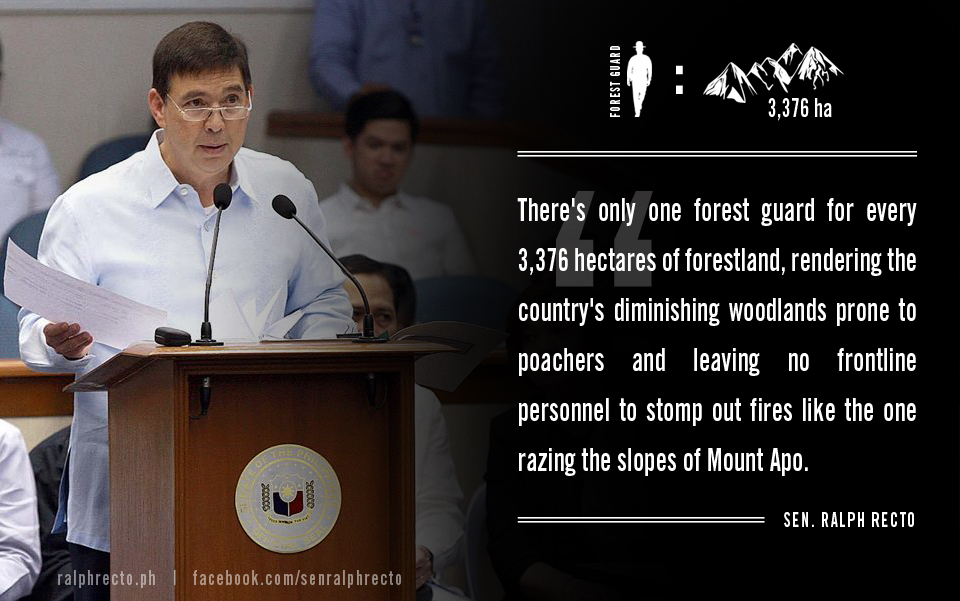Having 1 guard per 3,376 hectares of forest could lead to more Mount Apo-like fires – Recto
There’s only one forest guard for every 3,376 hectares of forestland, rendering the country’s diminishing woodlands prone to poachers and leaving no frontline personnel to stomp out fires like the one razing the slopes of Mount Apo, the country’s highest peak.
“The lack of forest rangers had reached general alarm a long time ago,” said Senate President Pro-Tempore Ralph Recto, who got the data on the dearth of forest guards from official reports sent to the Senate.
Recto said authorities should “now scramble to deploy more forest guards” as dry spells and El Niño caused by climate change leave forests tinder dry for long periods.
Another reason Recto cited is the need to protect the gains of the National Greening Program (NGP) which had re-greened 1,125,701 hectares of mostly logged-over areas with 678 million seedlings since 2011.
“We have invested P24 billion for this massive reforestation program,” Recto said, citing NGP’s budget from 2011 to 2015. “We have to protect this investment. Parang mahal na bahay ‘yan, kailangan ng fire extinguisher at fire insurance.”
The nationwide lack of forest guards can be gleaned from the number assigned in the Mount Apo National Park, which has 16 regular forest rangers guarding 54,975 hectares of main protected area, Recto said.
“That’s one guard for every 3,436 hectares,” Recto said.
“But if we include the 9,000 hectares of buffer and peripheral areas, the ratio goes up to almost one ranger per 4,000 hectares,” he added.
The same personnel lack also plagues other parks. In 2014, it was reported that there were only three full-time forest guards patrolling the 11,000-hectare Mount Banahaw protected area in Southern Tagalog.
About two dozen forest guards protect the 6,600-hectare Ipo Watershed in Bulacan from illegal loggers. That watersheds form part of the larger Angat watershed that supplies 97% of Metro Manila’s water.
But to the credit of the Aquino government, more guards and funds are being sent to forest frontiers, Recto said.
“There is now a forest protection fund of about P500 million. The budget for protected areas management has gone up to P720 million this year,” he said.
“Like in previous years, these allocations should fund the hiring of contractual forest guards,” Recto said. “But what we need are regular guards,” the senator admitted.
“Aside from hiring more manpower, forest protection equipment should also be procured and deployed. At present, there are no dedicated firetrucks for forest-fire suppression,” Recto said.
“Hindi rin yan nakakapagtaka, kasi nga 420 towns natin ay walang fire stations at mayroon lang tayong 1,574 firetrucks, or almost one per town lang,” Recto said.
He said the government’s shopping list for new aircraft must include planes and helicopters which can be outfitted with firefighting accessories.
Recto said upgrading firefighing capabilities should be included in the disaster risk reduction plan of the government.
“Dapat ang pamatay sunog ay bahagi ng ating disaster response and mitigation plans. Hindi lang bagyo ang kalamidad. Sunog rin. At kapag sunog, hindi lang kabahayan. kabundukan rin,” Recto added.
He said funds for forest protection can be sourced from the internally-generated income of the Department of Environment and Natural Resources (DENR).
For 2016, DENR is programmed to collect P2.2 billion from fees, permits, and royalties from natural resource extraction.
The biggest of these is the P1.5 billion collection quota of the Mines and Geo-Sciences Bureau. On forest charges some P154 million is forecast to be collected in 2016.
“Hindi pa kasama dito ang katas ng Malampaya,” Recto said, referring to the natural gas field off Palawan from which the government is expecting P35 billion in royalty payments this year.


